Author // Sarah Mowery Friday, 30 April 2021
School districts across the state of Ohio are developing extended learning plans to continue student acceleration of learning. This is the final blog in the series of Extended Learning Plans and the Simple View of Reading.
Literacy skills lay at the foundation for all learning. Success in reading, writing, speaking, and listening competencies is directly related to the language and literacy skills that students possess and has a direct impact on all content areas and across all grade levels. It is for this reason that a focus on literacy is important to include in extended learning plans.
Let INFOhio, Ohio's PreK-12 digital library, be your school district's partner as you accelerate and extend student learning. INFOhio offers a variety of PreK-12 digital learning resources at no cost to Ohio's students, educators, and parents that can support the the Simple View of Reading and the Simple View of Writing's framework that includes foundational transcription skills, self-regulation and executive function skills, and the development of text generation or translation skills. Writing skills are supported across the Language and Literacy Development Continuum.
Ohio's Plan to Raise Literacy Achievement is grounded in the framework of the Simple View of Reading and the Simple View of Writing instructional concepts that are needed in literacy development from emergent to adolescent language and literacy. Learning to write requires learners to develop two foundational skill sets: transcription skills and translation skills to gain the ability to have skilled written expression. This is the Simple View of Writing.
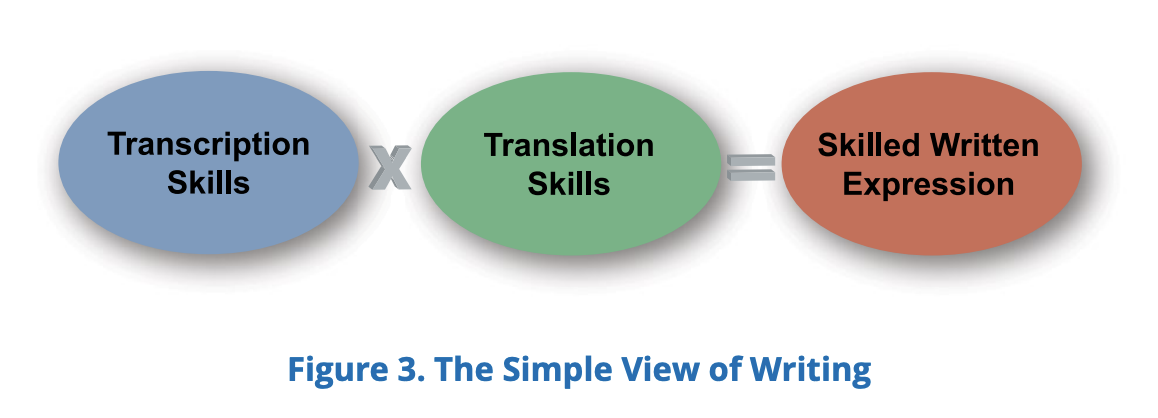
Using this formula helps educators identify areas of instructional need for striving readers and writers. The Simple View of Writing applies across all grade levels and can be used as a guide for your extended learning plan for literacy and writing instruction. Transcription, self regulation, executive function, and translation skills are components of the Language and Literacy Continuum of writing that INFOhio resources can help to support. Let the instructional components of the Simple View of Reading, the Simple View of Writing, and INFOhio help you help your learners this summer.
Writing is an essential part of literacy instruction. According to Ohio's Plan to Raise Literacy Achievement writing instruction skills fall into three categories:
Transcription skills include the foundational skills of letter formation, handwriting, keyboarding, punctuation, and spelling. These skills must be taught first and at varying levels of instruction in every grade level in order for translation or text generation skills to develop. Handwriting instruction is vital as it helps students get their thoughts down on paper. If students are struggling to write things down, this is going to make the quality and quantity of their writing decline.
Self-regulation and executive function are the ability to organize and handle multiple tasks, set goals, and plan; all skills needed for writing development. In order for students to communicate their thoughts through writing, multiple skills are necessary "to focus attention, remember instructions, juggle multiple tasks that are initially supported by others, and to coordinate transcription and text generation" (St. Martin, et. al. 2020).
Translation or text generation is the process of using correct grammar, sentence structure or syntax, putting together the information, writing for your audience, and following a writing process. Targeted instruction on writing skills is necessary to give students the ability to use critical thinking skills to retrieve information from what they have learned and then communicate these thoughts in a coherent way.
The charts below show the Learning Progression for Developing Skilled Writers. Transcription skills continuously build on translation skills as students develop. A constant throughout the writing progression is exposure to many different text structures such as narratives, fiction, nonfiction, advertisements, folktales, biographies, etc. More information about this progression can be found in Intensifying Literacy Instruction: Essential Practices.
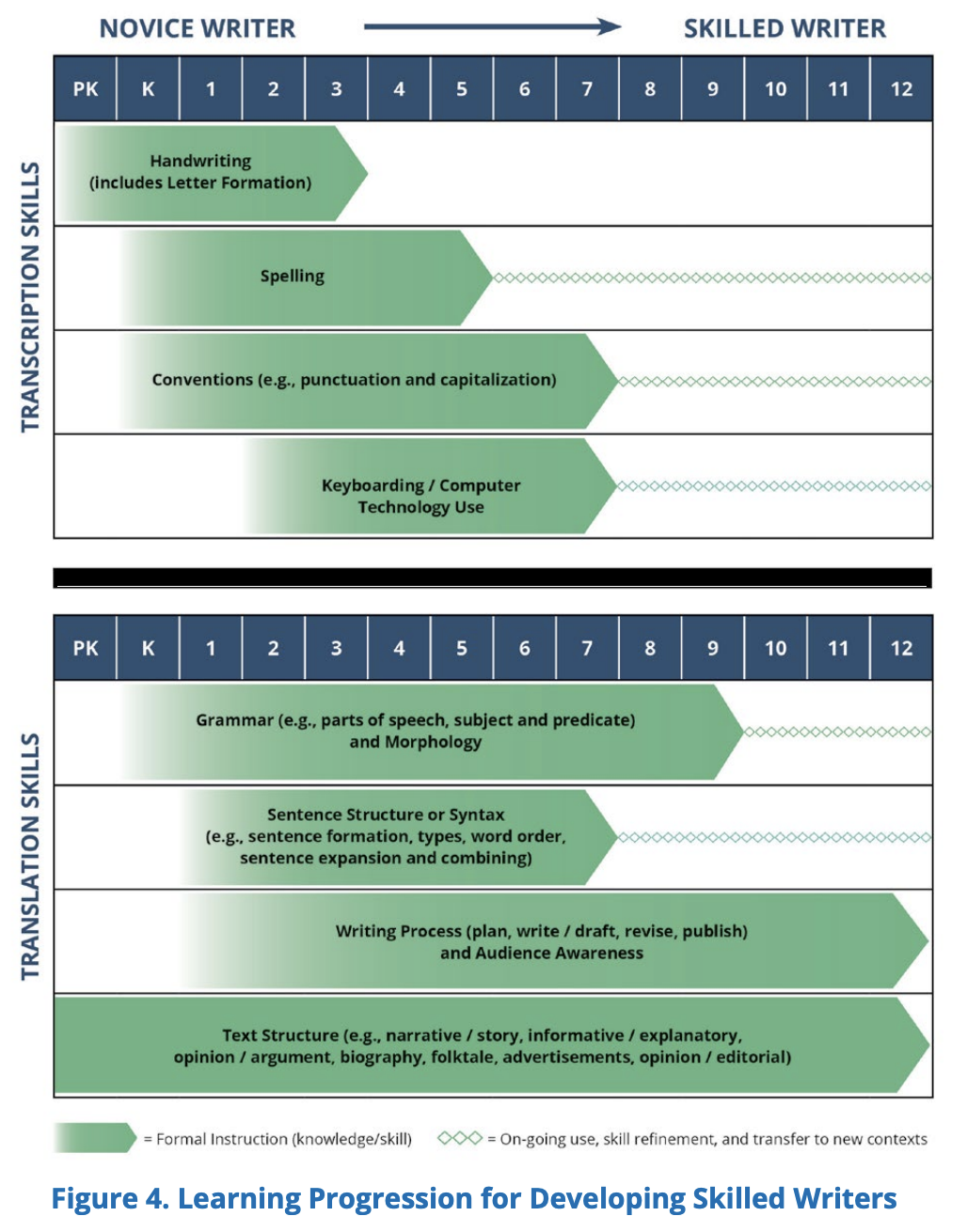
What are strategies or approaches that can help students become better writers?
It is important to remember that "students learn by doing [and] to become effective writers, students need daily opportunities to learn and practice writing skills, strategies, and techniques" (What Works Clearing House, 2017). Practice transcription skills by continuing to set aside time in early learning classrooms for letter formation and handwriting practice. In elementary classrooms and beyond practice keyboarding, have spelling tests, and daily grammar exercises. When handwriting and keyboarding become automatic and a part of students muscle memory, this will help students to put their full mental capacity on communicating their thoughts and not on the physical creation of letters or hunting and pecking for letters on a keyboard.
Teaching executive function skills will help students practice taking writing one step at a time. Teach students to stop and pause and check each sentence of a paragraph once they've finished the paragraph. Also encourage students to take breaks after writing a certain number of words.
For a scaffolded approach, provide paragraph frames and sentence starters to help students when they are stuck with where to start. These strategies also expose students to what good writing looks like. Also, use the writing process and help students understand the steps of planning, revising, editing, and creating a final draft. This will help students frame and communicate their thoughts well.
Quill Interactive Writing Instructional Materials
To help build these foundational skills and make better writers, teachers have access to Quill interactive writing instructional materials through INFOhio's Open Space. designed for 6th-12th grade students. Additional grade level activities for 1st-5th grade are currently being added as well.
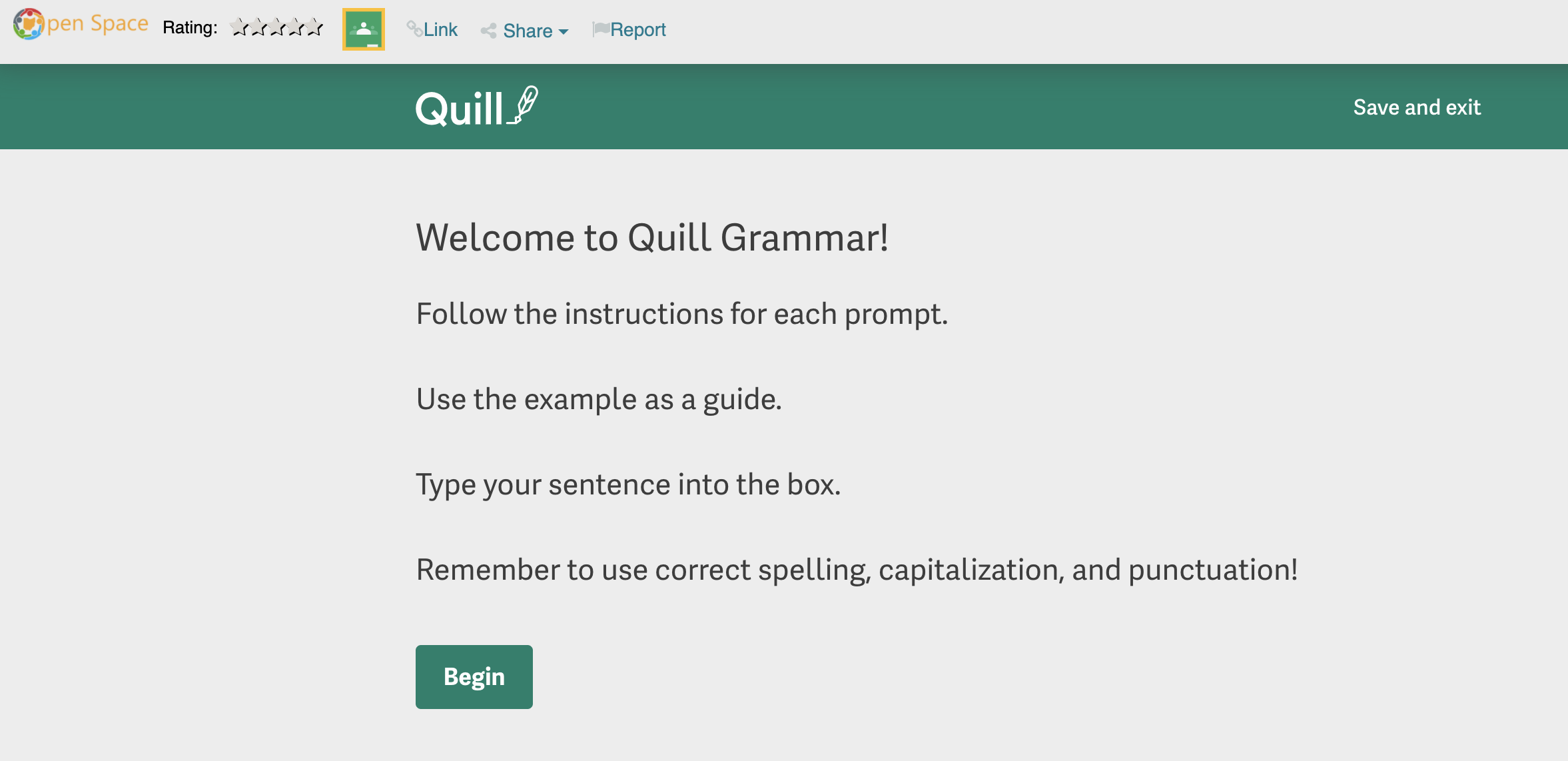
These interactive writing lessons and activities are appropriate for grades 6th-12th and have been provided by Quill, a nonprofit organization whose mission is to help all students become strong writers and critical thinkers. Most of the lessons are focused on boosting the transcription and translation skills of writing that students need to develop a solid writing background.
Every writer has different needs and to meet students where they are, Quill has also included a diagnostic tool to assess students and to design a personalized learning path to become stronger writers. Teachers can also choose from over 300 activities to assign to students through Google Classroom or by sharing the direct link.
Some of the most popular interactive lessons are:
Go! Ask, Act, Achieve
Writing is a process. Planning, revising, and editing work are essential for self-expression in quality writing. Using the inquiry-based learning approach, Go! Ask, Act, Achieve helps students organize their thinking as they write. It provides students in grades 4-10 with digital tools, graphic organizers, and resources to help students gather information, organize ideas, and develop ideas during the writing process. This INFOhio tool includes a Teacher Guide that offers mini lessons targeted at writing instruction. Teachers can scaffold these strategies by using the "Model-Practice-Reflect instructional cycle" (What Works Clearinghouse, 2016). Teachers begin by modeling how to use a writing strategy, then students practice the strategy independently, and reflect and evaluate their writing and strategy use.
For example, in the Ask component, of What do I already know? There are KWL graphic organizers to help students determine what they already know about their writing topic, what they want to know and find out, and what they have learned. This will help students with the planning process of writing and helps to identify gaps in their prior knowledge. The first two columns of the KWL chart are completed while doing their research and the last column is completed at the end.
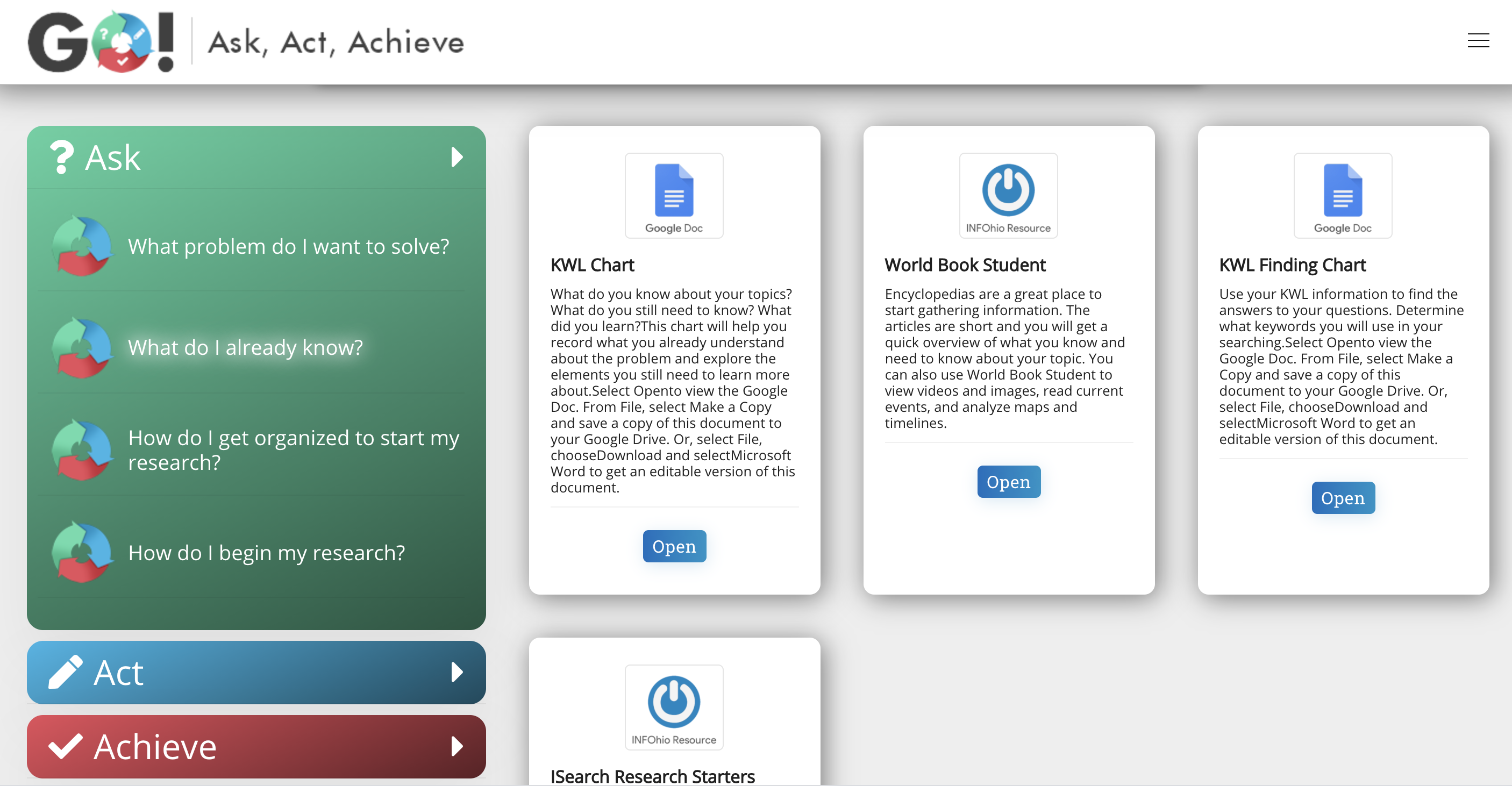
In the Act section of How do I organize my project? Use the Patterns of Organization Story Board, read about some of the common patterns, and choose the best type of writing pattern that will help students organize the information they have collected. Some examples of these are cause and effect, compare and contrast, chronological, etc. Specific writing genres may also already be a part of the curriculum and can be selected for use in the classroom.
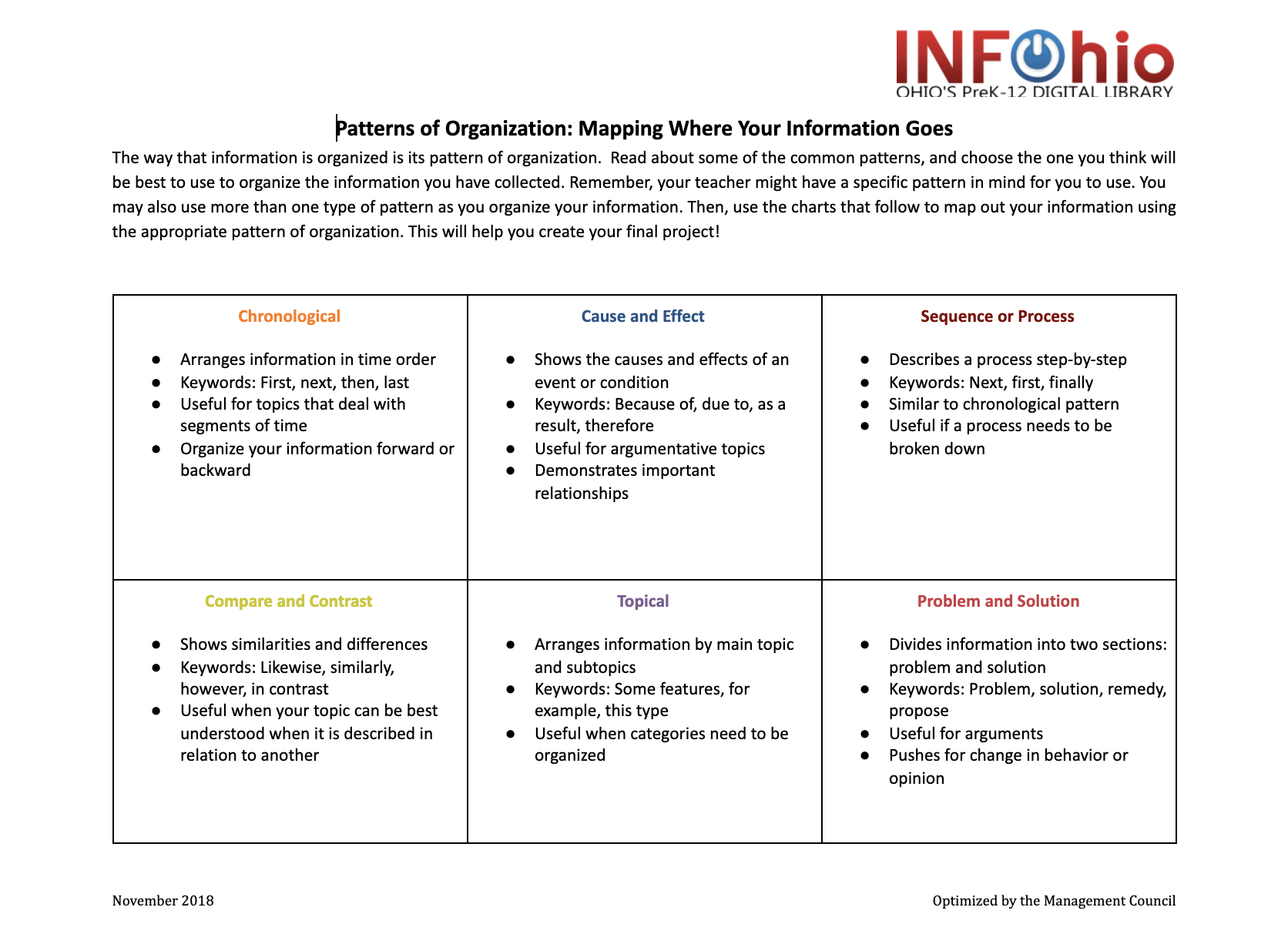
Research 4 Success
Research 4 Success, is designed for students in grades 11-12, and includes six modules in a blended learning course to help teach rigorous research skills. The six modules in Research 4 Success are grounded in inquiry-based learning. Each module provides students the opportunity to learn, practice, and apply key writing and research skills. Students learn how to locate, evaluate, organize, and analyze information from text. Students learn, practice, and apply the writing process as they draft, edit, and revise their work as they complete each module.
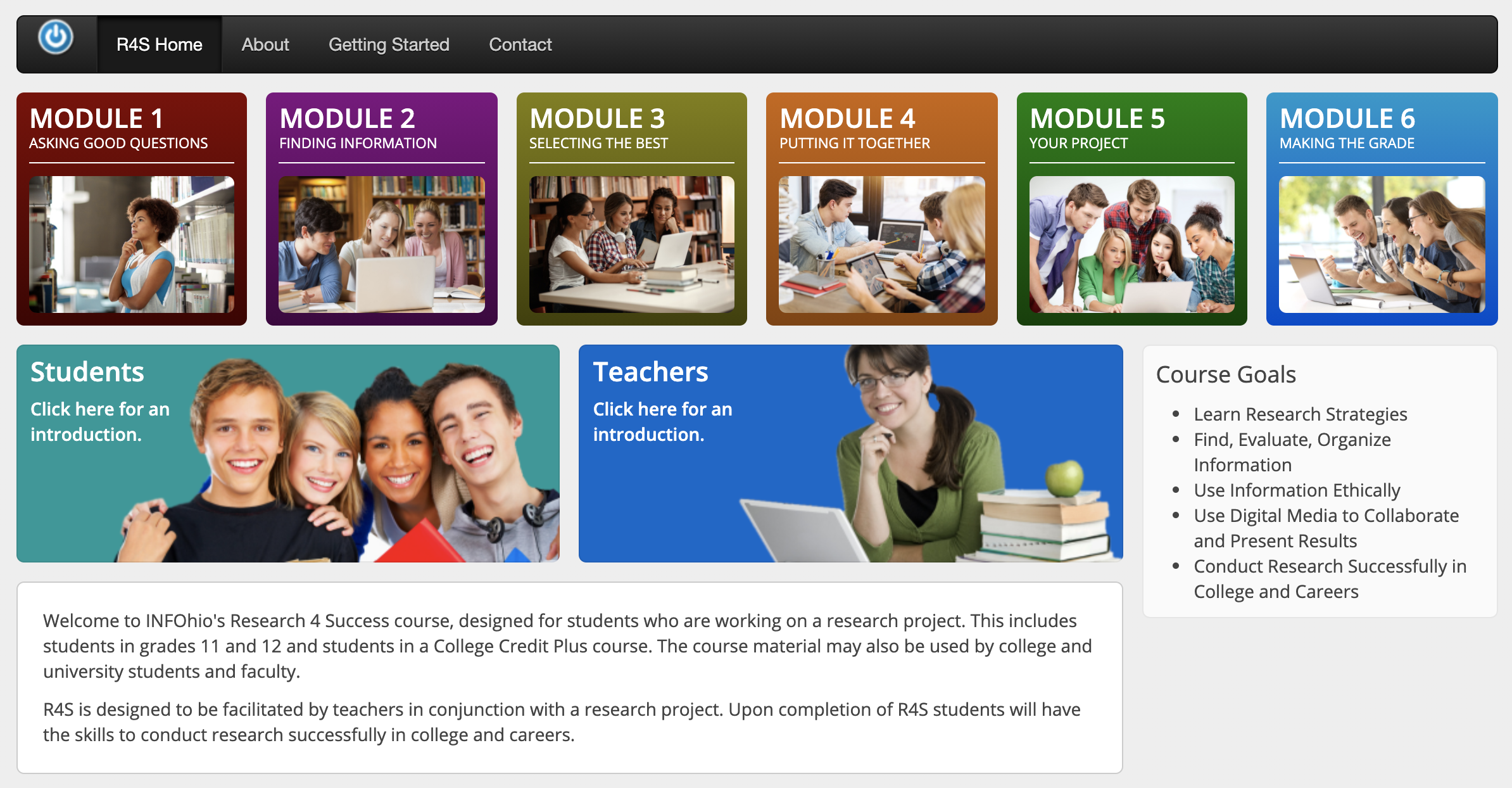
Both tools, Go! Ask, Act, Achieve and Research 4 Success, provide the guided steps necessary to complete the writing process. Deciding on a writing topic, planning, finding, evaluating, and organizing information are all outlined in these tools and provide graphic organizers and supports to scaffold each step.
Educator Tools
Educator Tools, INFOhio's repository of high-quality, standards-aligned instructional materials includes more than 80,000 teacher-approved lesson plans, learning activities, assessments, and other instructional materials to support personalized learning, project-based learning, and the inquiry process.
When doing a search for sentence starters, over 1,000 writing activities are found. With Educator Tools you can easily limit your search results by grade level, subject, item type, or instructional trend to get more focused search results. You can also click the heart in the bottom left corner of each item to make them your favorite. Then, you can email your favorites list to yourself or a colleague to use later. Additional search terms to support the scaffolded approach to writing and to help students get started with writing could be, "paragraph frames," "sentence frames," or "sentence stems."
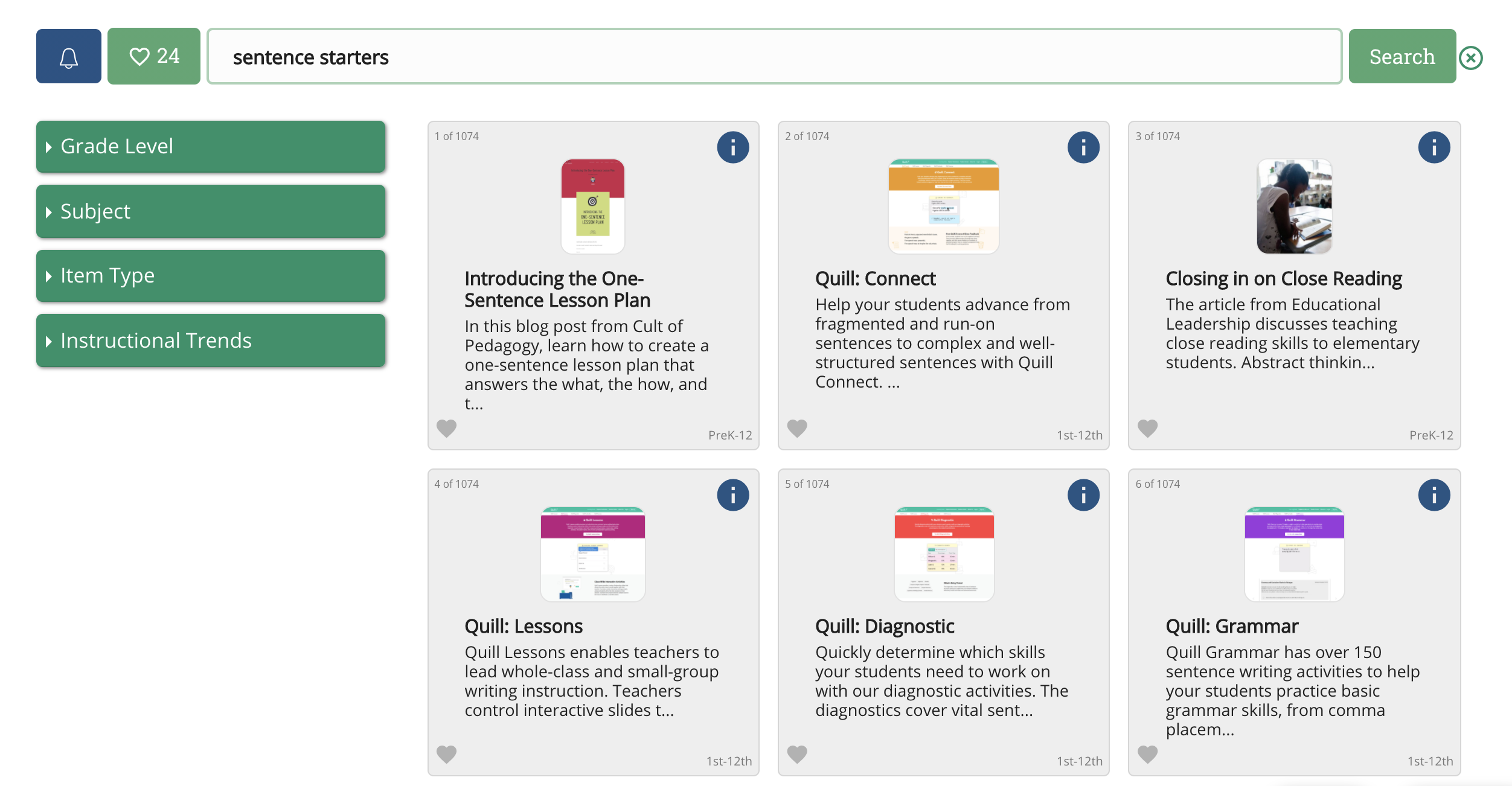
INFOhio, Ohio's PreK-12 Digital Library, is dedicated to providing equitable access to quality instructional materials to meet students where they are. All resources are provided at no cost to Ohio's educators, students, and families. To help support teachers with the instructional components in the Simple View of Reading and Simple View of Writing and help you plan for extended learning check out the first five blogs in this series:
INFOhio has what you need to engage learners in extended learning activities that will accelerate learning and provide access to multiple, quality digital resources across the disciplines.
We are always here to help! If you need further support or have any questions, contact support.infohio.org.
Sarah Mowery is a Professional Instructional Specialist with INFOhio. She has worked in education for 16 years as a school librarian and technology coach in elementary and middle school settings. While in these roles, she's been an integral part of the building leadership teams working as a curriculum connector and integrating web-based tools. She earned a BA in Sociology from Bowling Green State University and an MLS with a specialization in PK-12 schools from East Carolina University. Sarah was one of the original INFOhio ICoaches when the program first began in 2013 and has a passion for sharing how INFOhio resources can transform teaching and impact learning for students and educators across the state of Ohio.
Fetch is avaiable to INFOhio automated schools. If you are an INFOhio school, please log in with your school username/password using the button at the top-left corner of this page.
For more information about Fetch, please visit the Fetch information page or contact INFOhio support at https://support.infohio.org.